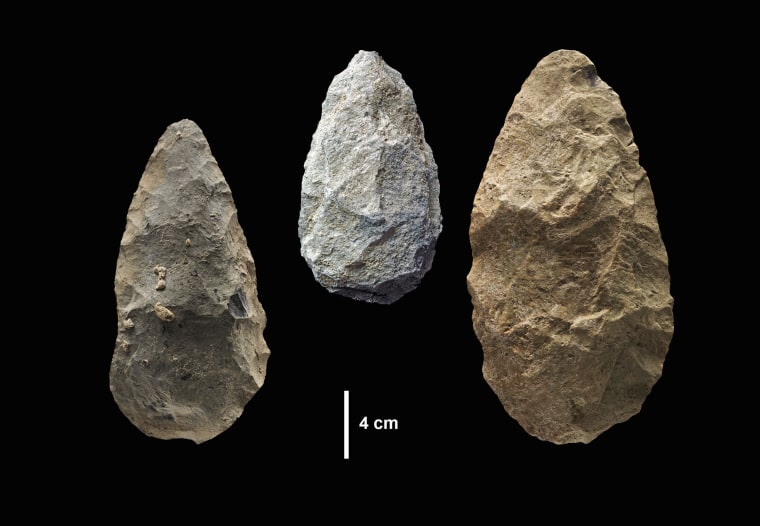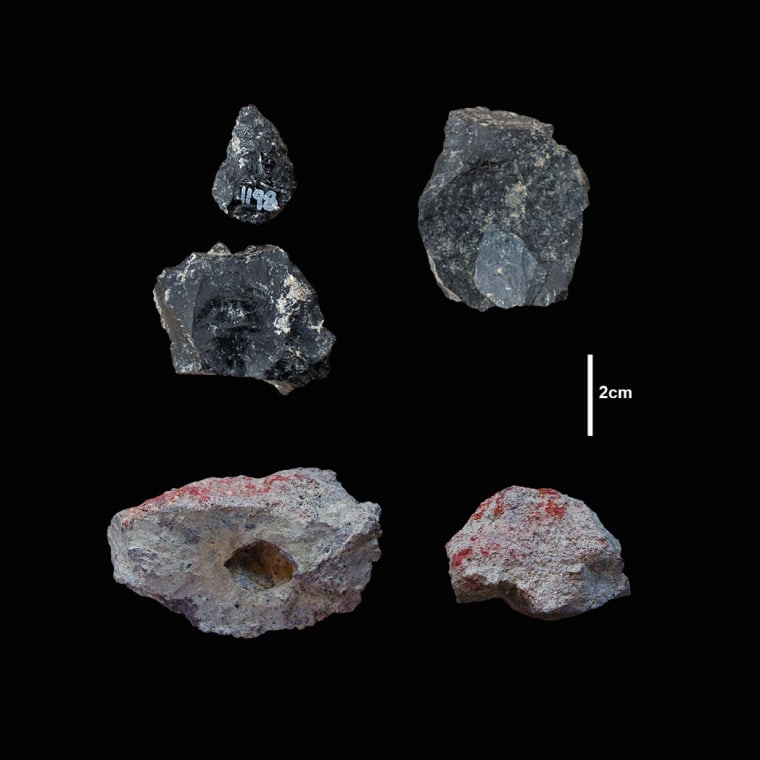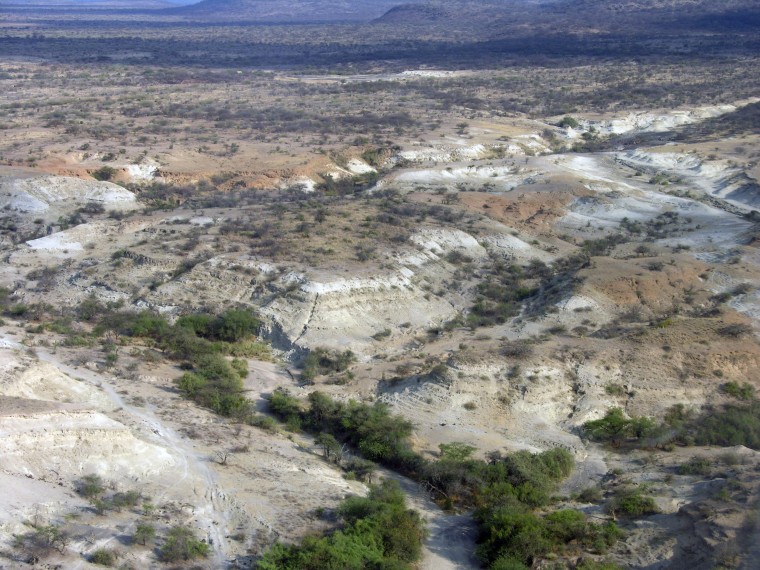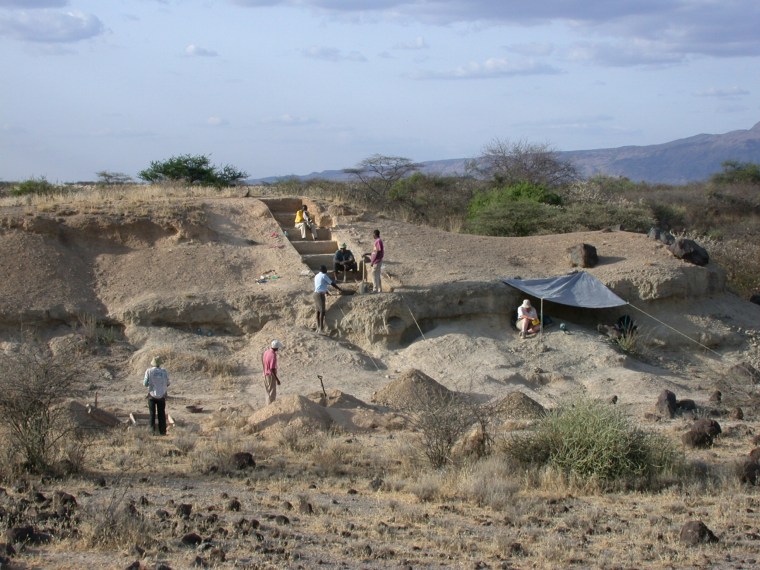Half a million years ago, something big happened in east Africa.
It was a big enough change to transform the terrain, reshape the landscape and to alter the populations of animals living there.
And it completely transformed the early humans who lived there.
“What we are seeing is the demise of a way of life in early human ancestors that persisted for hundreds of thousands of years,” said paleoanthropologist Rick Potts, who heads the Smithsonian's Human Origins Program.
Before the change, pre-humans such as Homo erectus had lived happily for millennia using crude, heavy stone axes. Afterwards, the early humans living in the area traded for sharp, strong obsidian and made delicate tools and spear heads. They learned to hunt new kinds of animals and they carried around a lot of raw materials for making black and red paint or ink.

New studies from Potts and colleagues published Thursday paint a clear picture of a time of total disruption in what is now southwestern Kenya. Not only do they document periods of devastating earthquakes, but climate change that transformed the area from a rich, stable plain to an area ravaged by unpredictable floods, intense thunderstorms and then long droughts.
There’s not much evidence of anything between about 500,000 years ago, and 320,000 years ago. But the transformation is sweeping.
Giant ancestors of elephants, zebra and baboon-like apes disappeared, to be replaced by more modern-looking grazers such as antelope and oryx.
The humans who lived there changed — a lot. Big, clumsy stone axes known as Acheulean tools disappear and instead the archeologists found finer, lighter and more varied tools. They’re made from materials not found locally, such as obsidian and chert, which indicates they were carried and traded over distances.

“The large, clunky technology is gone and in its place is a smaller technology, more mobile,” said Potts. “What we are looking at is a real change from the hand ax times. Think of the same technology produced over and over again for hundreds of thousands of years. That’s not us. I can barely keep up with the latest version of Windows,” he said.
“The history of technology has been the same ever since, going from large and clunky to small and portable.”
Early humans had to adapt
It’s not clear which species of early humans is responsible for the artifacts. Homo erectus and Homo heidelbergensis both lived on the African continent. But Homo sapiens fossils from Morocco date back to 300,000 or so years ago.
“This represents a significant revision in African hominin behavior at or near the time of origin of Homo sapiens,” the teams of scientists wrote in one of the reports published in the journal Science on Thursday.
Whatever species they were, they had to adapt to the climate changes, the natural disasters and the disappearance of the foods they were used to eating; they had to learn how to communicate with other groups of hominids, how to trade information and trade tools and, possibly, food.
“All of these are fundamental aspects of our humanity that are right there at the beginning of our species,” Potts said.
“The history of technology has been the same ever since, going from large and clunky to small and portable.”
The ancient people used dye.
The team found rocks with streaks of pigment, blocks of iron-rich minerals used to make ochre and other colors, and pretty colored stones carried from afar.
That shows people were thinking beyond the simple needs of survival.
“Color is the root of complex, symbolic behavior in humans,” said Potts. “We use it in clothing, uniforms, flags, tattoos — whatever ways we have of signaling that I am a member of this particular group.”
What were these early Africans doing with the lumps of coloring?
“We don’t know what they were applying it to but they almost certainly applying it to something; perhaps their skin or hair,” Pott said. “That is a pretty human characteristic.”
In other words, the early humans who lived in this area were becoming more like modern humans. And it sure looks like the dramatic changes were forcing it.
“All this transition, this transformation of human behavior is occurring at a time of upheaval of the landscape,” Potts said.

It’s not news to anyone that human beings adapt and even evolve in the face of change. As the Ice Age glaciers receded, so did Neanderthals, to be replaced by modern Homo sapiens from the Near East and Africa.
What about humans now?
But this change was happening 320,000 years ago. The indications are that trade was taking place 100,000 years earlier than anthropologists have believed.
What do the changes say about humans alive today in a time of climate change?
“We certainly are running an experiment right now where humans are taking what is already a dynamic planet and messing with it,” Potts said.
The findings in Kenya indicate people can likely survive. “I tend to be optimistic in that the adaptability of human beings tends to be pretty astonishing,” Potts said.
But he points to the profound transformation of the hominids of prehistoric Kenya.
“Often what people mean by survival in a modern context means whether their way of life will persist and thrive,” he added. “The moral of this story is that the status quo does not survive.”



